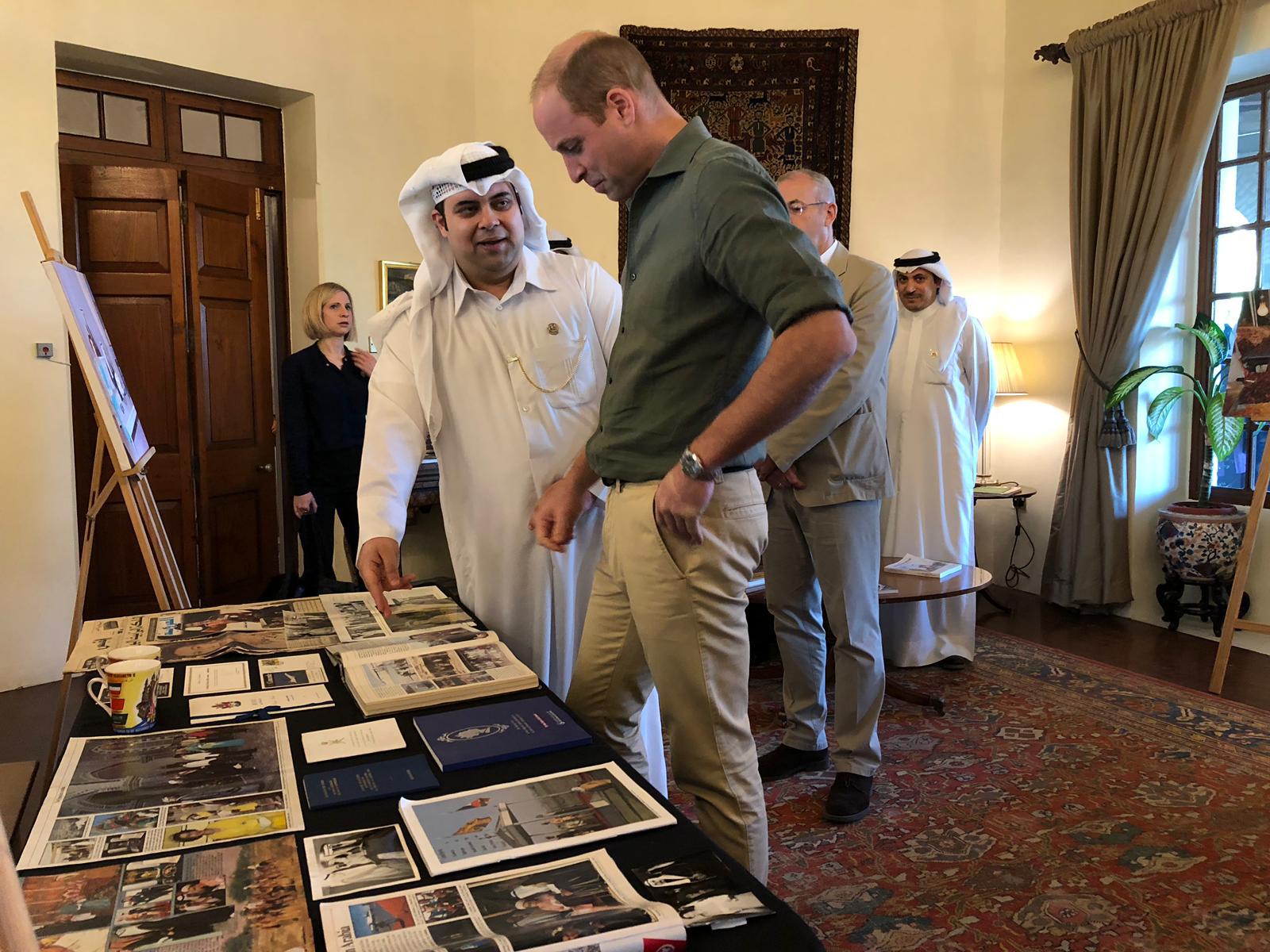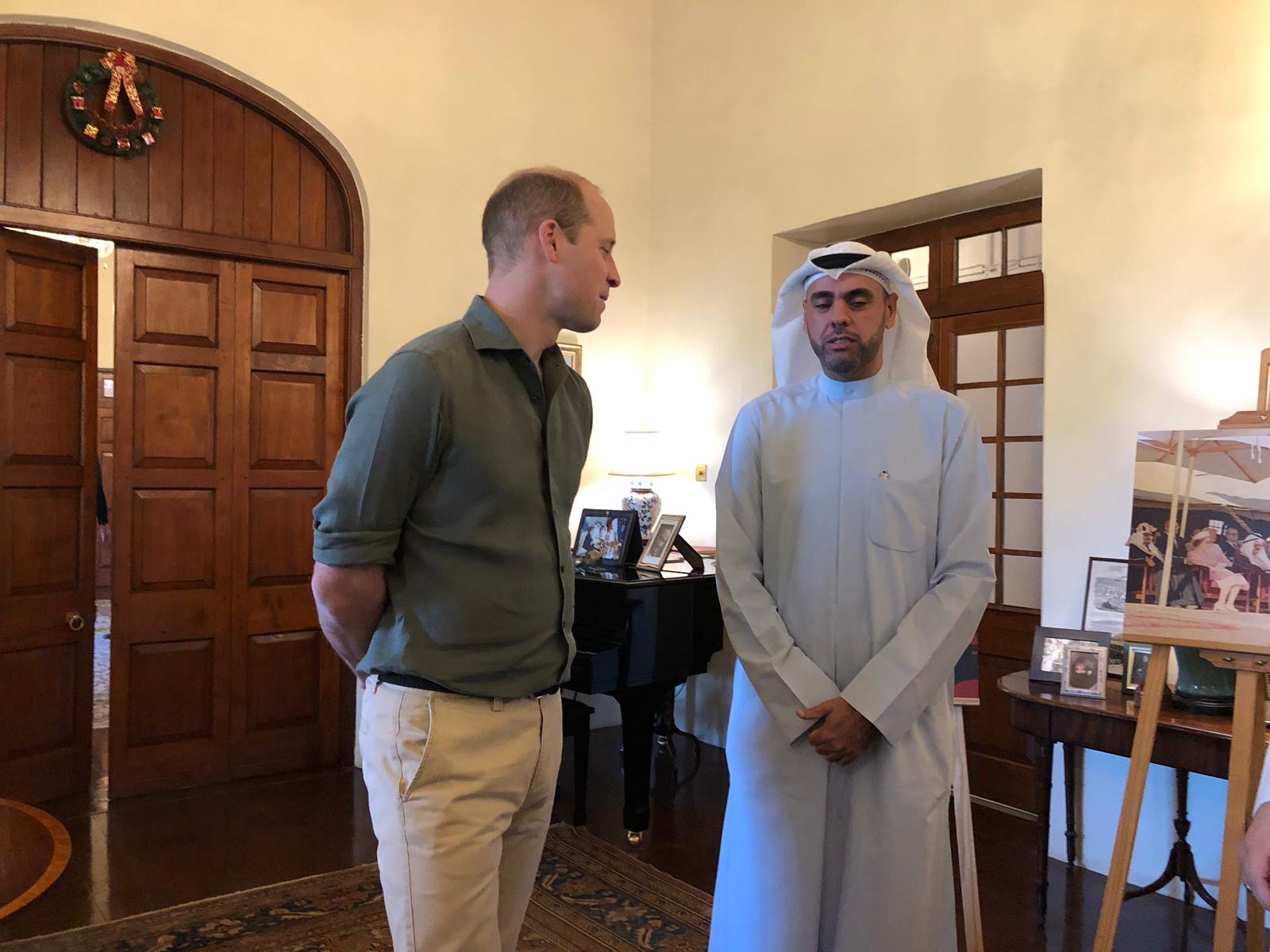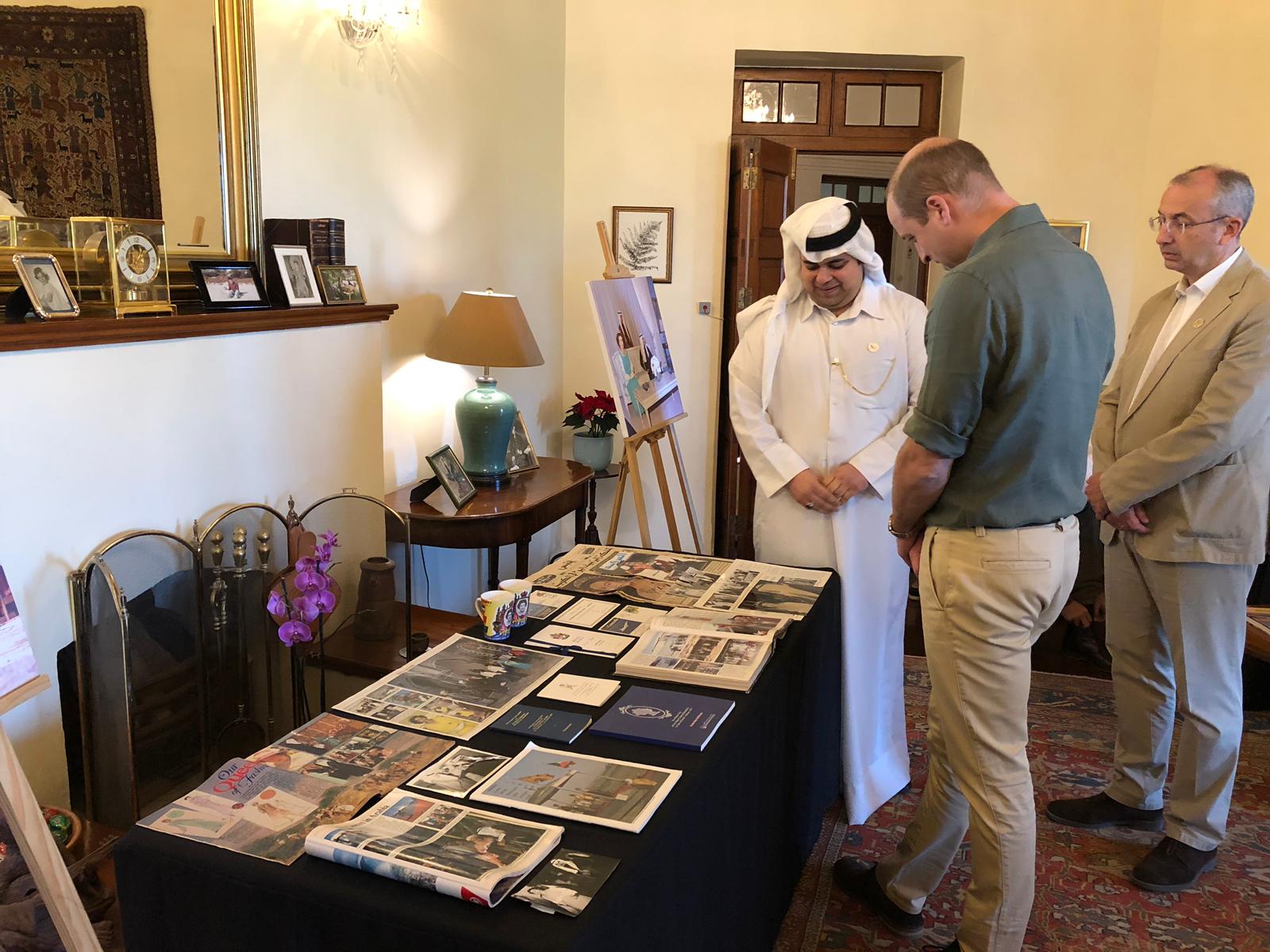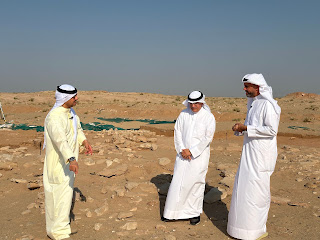Hasan Ashhakani, assistant professor of Anthropological Archaeology at Kuwait University. صفحة د. حسن جاسم أشكناني، استاذ الأنثروبولوجيا والآثار في جامعة الكويت
Sunday, November 24, 2024
the Order of the Star of Italy from the President of Italy وسام رئيس ايطاليا
وسام نجمة إيطاليا رتبة فارسمن الرئيس الإيطالي سيرجو ماترلا
Hasan Ashkanani honored with the Order of the Star of Italy from the President of Italy for promoting cross-cultural links between Kuwait and Italy.
Prince William in Kuwait Dec 20219, British Residency
honorary meeting with Prince William in Kuwait Dec 20219, British Residency
الأمير ويليام كرَّم منظمي احتفالات معاهدة الصداقة
التقى دشتي وأشكناني والهندال واطلع على وثائق الزيارات البريطانية
- 06-12-2019

Monday, November 18, 2024
Sabbyia Courtyard 7700 years
اكتشاف فناء وورشة صناعة الخرز في الصبية بشمال الكويت يعود الى ثقافة العبيد من ٧٧٠٠ سنة
استأنفت البعثة الأثرية الكويتية البولندية عملها في موقع بحرة 1، وهو مستوطنة ما قبل التاريخ تقع في صحراء الصبية شمال الكويت. يعود تاريخ بحرة 1 إلى ٥٧٠٠ قبل الميلاد وهي تُعرف بأنها أقدم وأكبر مستوطنة معروفة في شبه الجزيرة العربية من فترة العبيد.
منذ عام 2009، كانت بحرة 1 نقطة محورية للبحث الأثري، بفضل التعاون بين المجلس الوطني للثقافة والفنون والآداب الكويتي والمركز البولندي لآثار البحر الأبيض المتوسط في جامعة وارسو. يشرف على البعثة البروفيسور بيوتر بيلينسكي (PCMA UW) مع الدكتورة أجنيسكا بينكوفسكا التي ترأس الفريق كنائبة للمدير خلال هذا الموسم.
ومن أمام الموقع الاثري صرح السيد محمد بن رضا - الأمين العام المساعد لقطاع الآثار والمتاحف بالتكليف في المجلس الوطني للثقافة والفنون والآداب – ان فريق البعثة البولندية اكتشفت فيها هذا الموسم عن ما يحتمل ان تكون فناء او ورشة لصناعة الحلي والزينة المصنوعة من الأصداف حيث عثر على العديد منها من امام مساكن ثقافة العييد التي تم التنقيب عنها في مواسم مختلفة، بالإضافة الى العديد من الفخاريات التي تتجاوز ال ٧٠٠٠ سنة، وكذلك راس صغير لآدمي مصنوع من الطين وهو يعتبر الاول من نوعه في منطقة الخليج العربي.
وذكر السيد محمد بن رضا أن المجلس الوطني للثقافة والفنون الآداب بدأ في هذا الموسم باشراك قطاعات مختلفة للتعاون مع البعثات الأثرية في الكويت وتحديدا بين جامعة الكويت والبعثة البولندية لاستخدام اجهزة مختبرية حديثة للاجابة على تساولات مصدر المواد الأصلية المستخدمة في الموقع وكذلك أنواع النباتات والبيئة القديمة.
وصرح الدكتور حسن أشكناني – أستاذ الآثار والانثروبولوجيا في جامعة الكويت ان اكتشاف الراس الادمي الذي يعود إلى ٧٧٠٠- ٧٥٠٠ سنة يعتبر من اهم الاكتشافات الأكثر إثارة للإعجاب في هذا الموسم من التنقيب الأثري.
ويذكر الدكتور حسن ان حسب النقاشات العلمية مع البعثة البولندية ان على الرغم من صغر حجمها، رأس صغير من الطين مصنوع بدقة ويتميز بجمجمة مستطيلة وعينين مائلتين وأنف مسطح - وهي سمة مميزة للتماثيل الصغيرة من ثقافة عبيد. وقد تم العثور على تماثيل من هذا النوع في سياقات قبرية ومنزلية في بلاد ما بين النهرين، ولكن هذا الاكتشاف في موقع بحرة 1 إضافة الى الورشة. يعطي تصورا اعمق لتطور ثقافة الإنسان في العصر الحجري الحديث.
ويقول البروفيسور بيوتر بيلينسكي، المدير المشارك للبعثة، الذي درس القطعة: "إن وجودها في بحرة 1 يثير أسئلة مثيرة للاهتمام حول غرضها والقيمة الرمزية أو ربما الطقسية التي كانت تحملها لشعب هذا المجتمع القديم".
ومن بين الاكتشافات المحورية الأخرى في بحرة 1، وجود أدلة على إنتاج الفخار المحلي. وقد تم التعرف على نوعين من الفخار في بحرة 1: فخار عبيد مستورد ونوع معروف باسم الفخار الأحمر الخشن. ولطالما اعتُبر هذا النوع من الفخار منتجًا محليًا في منطقة الخليج، ولكن الأدلة القاطعة جاءت أخيرًا من موقع بحرة 1، بما في ذلك وعاء من الطين غير المحروق. وتؤكد هذه النتائج، فضلاً عن التحليلات العلمية التي أجريت تحت إشراف البروفيسورة آنا سموجورزيوسكا، أن بحرة 1 هي أقدم موقع معروف لإنتاج الفخار في الخليج، مما يؤكد على تطور هذه المستوطنة القديمة.
كما انضم لهذا الموسم الدكتور رومان هوفسيبيان
المتخصص في علم الآثار النباتية، لفحص شظايا فخارية مختارة بحثًا عن آثار نباتات ستساعد في تحديد النباتات المحلية من منتصف الألفية السادسة قبل الميلاد.
—
A newly discovery of courtyard and beads workshop in Sabbyia (North Kuwait) retakes to Ubaid Culture dating to 7700 years ago
The Kuwaiti-Polish Archaeological Mission (KPAM) has resumed its work at the Bahra 1 site, a prehistoric settlement located in the Sabbyia desert of Northern Kuwait. Dating back to the mid-6th millennium BCE (5700 BC). Bahra 1 is recognized as the oldest and largest known settlements on the Arabian Peninsula from the Ubaid period.
Since 2009, Bahra 1 has been a focal point for archaeological research, facilitated by the collaboration between Kuwait’s National Council of Culture, Arts, and Letters (NCCAL) and the Polish Centre of Mediterranean Archaeology at the University of Warsaw (PCMA UW). The expedition is co-directed by Prof. Piotr Bieliński (PCMA UW), with Dr. Agnieszka Pieńkowska heading the team as deputy director during this season.
In front of the archaeological site, Mr. Mohammed bin Redha - Acting Under Secretary-General for the Antiquities and Museums Sector at the National Council for Culture, Arts and Letters - said that a team is seeking to discover this season what is likely to be a workshop or courtyard for making ornaments from shells, as many of them were found in front of the residential structures of the Ubaid culture that were excavated in different seasons, in addition to many pottery items that exceeded 7 thousand years, in addition to a small human head made of clay, which is considered the first of its kind in the Arabian Gulf region.
Mr. Mohammed bin Redha stated that the National Council for Culture, Arts and Letters began this season by involving Poland with various institutes in Kuwait such as Kuwait University to utliize modern laboratory equipment to answer questions about the source of the original materials used in the site in addition to the types of ancient plants.
Dr. Hasan Ashkanani - assistant Professor of Archaeology and Anthropology at Kuwait University stated that the discovery of the human head dating back to 7700- 7500 years is considered one of the important discovery and much excitement in this season of excavation. Despite its small size, Dr. Hasan notes, the small clay head has an elongated skull, slanted eyes and a flat nose – a characteristic feature of Ubaid figurines.
According to the discussion with the Polish team. Remains of this type have been found in grave and household agreements in Mesopotamia, but this could not be at the site of Bahra 1, in addition to the workshop. It gives a deeper insight into the development of human culture in the Neolithic period.
“Its presence at Bahra 1 raises questions about the function and the symbolic or perhaps ritual value it had for the people of this ancient society,” says Professor Piotr Bielinski, co-director of the expedition, who studied the statue.
Another pivotal discovery at Bahra 1 involves evidence of local pottery production. Two types of pottery have been identified at Bahra 1: imported Ubaid ware and a type known as Coarse Red Ware (CRW). The latter has long been regarded as produced locally, in the Gulf region, but conclusive evidence finally came from the Bahra 1 site, including an unfired clay vessel. These findings, as well as scientific analyses conducted under the direction of Prof. Anna Smogorzewska, confirm that Bahra 1 is the oldest known pottery production site in the Gulf, underscoring the sophistication of this ancient settlement.
Just joined the team in 2024 season, Dr. Roman Hovsepyan, a specialist in archaeobotany, is examining selected pottery fragments for traces of plants that will help identify local flora from the mid-6th millennium BCE.
https://www.kuna.net.kw/ArticleDetails.aspx?id=3201862&language=ar
https://www.alraimedia.com/ampArticle/1708427
Saturday, November 9, 2024
Dilmun Temple Discovered اكتشاف معبد من العصر البرونزي يعود إلى 4000 عام لحضارة دلمون في جزيرة فيلكا




















































